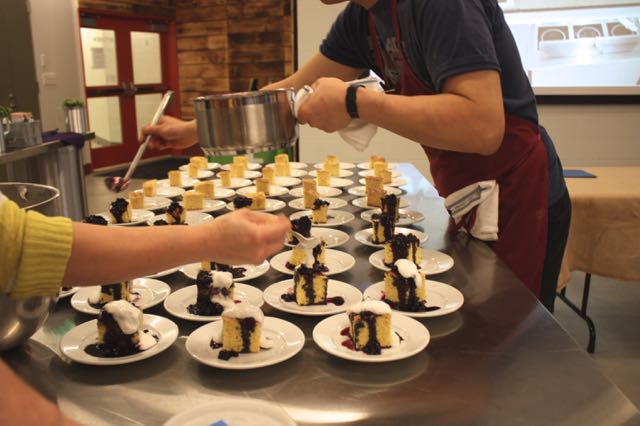Hey Friends! Here I am in my happy place…educating FODMAPers! 🙂
Hope you are all doing well. This past Sunday, I was spent the afternoon talking about my favorite topic, the low FODMAP diet during a fantastic event hosted by Foodicine Health. I was partnered with one of Food and Wine’s Best New Chef’s of 2015, Tim Maslow of Ribelle in Brookline, Massachusetts and Strip-Ts in Watertown, Massachusetts. Chef Tim prepared an amazing low FODMAP menu and I provided nutrition education about the low FODMAP diet!
Here Chef Tim shares the name of a Korean red chili that he likes to use in his cooking!
Chef Tim prepared an amazing Thai inspired Quinoa seasoned with fish sauce, cilantro, mint, green scallion, jalapeño, a flavorful mix of roasted seeds, and an assortment of beautiful citrus: lime, orange and lemons. He also prepared a creamy Japanese Risotto with shrimp and an interesting and tasty dessert, Bluebery Airgre Doux (sweet and sour blueberries.)
The low FODMAP diet never tasted so good! Seriously.
Plating the delicious blueberry dessert with a coconut whipped topping!
We had over 50 lively and engaging attendees. Some of which, read my blog….so thanks for coming!
In Australia, there is an emergence of restaurants featuring low FODMAP dishes and I sure hope this trend starts here in the US. As you know, dining out can be tricky for low FODMAP diet followers due to presence of garlic and onion in most prepared restaurant dishes.
One of Foodicine Health’s missions is to increase awareness of the need for more tolerable food options for people with food allergies and/or intolerances in restaurants, in the college setting, airports etc.! Part of this mission can start with you! Together we can help educate chefs and restaurants about the low FODMAP diet.
Here is a few tips to help this grassroots effort to create more safe options for all….because everyone deserves a night off of cooking and the possibility of dining out without consequence!
- Research and preview the menus of restaurants in your area online prior to arriving at the restaurant. You will feel more prepared to order a menu item that will be appealing, easily adaptable to reduce FODMAPs and suitable for you and your sensitive gut.
- Call the restaurant during less busy hours, around 3-4 PM to ask about food options that can prepared without FODMAPs.
- Encourage the staff to learn more about the low FODMAP diet, a researched based diet therapy that helps manage digestive symptoms in 3 out of 4 individuals that suffer with IBS! Feel free to ask the chef to call me or my office (508-533-0800)….we can help them prepare low FODMAP selections!
- Ask if they might carry sourdough bread (made without yeast) or gluten free buns so can enjoy along with a plain grilled burger, BLT or chicken breast topped with lettuce, tomato, mustard, mayonnaise and/or a pickle!
- Ask if they will or already have milk alternatives available should you want to top off your coffee or tea with a low lactose alternative.
I firmly believe more restaurants will begin to adapt some of their menu items for the growing number of patrons that have digestive woes. The more we talk openly about the low FODMAP diet …the greater the awareness will be.




Vivian
Since the typical busy person’s daily food involves dining out frequently this is so wonderful!
Keep educating the restaurant and food industry. Thanks for all that you do.
Terri
I am very interested in dining out options. My 10 year old son was diagnosed with SIBO last summer. We started the FODMAP diet once we received the diagnosis. He was still having issues so I got him allergy tested by Dr. Hunton an integrative specialist. He now needs to be dairy free and wheat free as well as a bunch of other things so we are still trying to figure everything out at home. It also seems like a lot of the things he is not allergic to are high fodmap foods so it is limiting what he can eat. I am pretty nervous about eating out with him. He has had bellyaches for almost 2 years now so I am very thankful for the diagnosis but it certainly is overwhelming trying to figure everything out. He is very active in sports and has practice throughout the week so I do not cook every night. Having good options when dining out is important to us. I try to plan ahead but it doesn’t always happen. I really enjoy your website and any advice would be appreciated.
Christine
Hi Kate,
thank you so much for this post! I never got the idea that we might be able to encourage restaurants to adapt to our FODMAP needs. And it makes sense for them as well as so many people suffer under IBS.
I have SIBO and need to avoid starches as well. I just read that “starches’ physical-chemical properties evolve when they come in contact with water, undergo temperature variations and as time passes”. I cook usually big portions and eat them for several days as only small amounts are allowed. Are veggies like carrots, spagetti squash and zucchini and rice more difficult to digest after one or two days in the fridge and reheated? I would be very happy to see some light in the dark! Many thanks, for your excellent work!
Christine
katescarlata
Starch is a bit complicated. Starchy foods can become resistant starch when cooled (think cold potato salad vs. hot baked potato)–but starches will revert back when re-heated. The amylose-amylopectin content varies from one starch to another–another interesting part of the science of starch. The amylopectin is easier and faster to break down in the gut—making it a potentially better option for someone w/ SIBO. Unfortunately, there is so little research about diet and SIBO—and I think most people are too restrictive with the diet post SIBO diagnosis that many become malnourished! This is unfortunate–and not necessary in my opinion. I typically allow starch for most of my SIBO patients—unless they become very symptomatic when they eat it. And do find in my clinical practice that the low FODMAP diet helps many with SIBO—but I try to liberalize the diet soon after they are treated–as tolerated. Trying to determine the underlying cause of why you developed SIBO is important too—so work with a good GI doctor to try to test for overlapping conditions that may have predisposed you to developing SIBO in the first place.
Christine
Thank you so much, Kate! This is very helpful. To know starch reverts back when heated… I am wondering if starch should be avoided because of symptoms it may cause or because it feeds the bacteria… I never get the SIBO really away and I am best when very restricted. As soon as I start to reintroduce I am getting much worse. I know it is a question of portion size. If I eat 10 almonds and 1/4 cup broccoli is this already to much or is it ok. to stay at the upper end of the still green amount for several foods (according to Monach App)?
Christy
Thank you so much for this amazing post – I so hope that it goes viral. I “figured all of this out” the hard way a few years ago – but this post will be extremely beneficial to those who haven’t learned the tricks of eating out safely (and it is a constant challenge!). Moreover, I am incredibly grateful for your willingness to educate chefs! Thank you for all you do to help others with IBS!